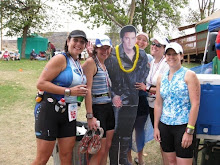By Claire Martin
Women's Health
Have you ever stopped to wonder why it's so freakin' hard to do a simple pullup? Well, here's the answer: physics. When you do a pullup, your body is in a position that forces your back and arms to lift your entire body weight, so the scientific laws of motion and leverage are working against you. In other words, says Alwyn Cosgrove, your body becomes an uber — efficient resistance machine.
All bodyweight exercises can be just as challenging (and effective) as a pullup if you apply the body-trimming physics of these principles.
Law No. 1: To Get Leaner, Be Longer
The Science:As you increase the distance between the point of force (your target muscles) and the end of the object you're trying to lift (your body), you decrease your mechanical advantage. Translation: The longer your body, the weaker you become and the more your muscles have to work. This is the major difference between "girly" pushups and regular ones. When you get off your knees and rest on your toes, your core muscles have to work a whole lot harder to support more of your body weight.
Apply It:
Raise your hands above your head so your arms are straight and in line with your body during lunges, squats, crunches, or situps. Too hard? Split the distance by putting your hands behind your head.
Law No. 2: Take the Spring Out of Your Step
The Science:When you lower your body during any exercise, your muscles build up what's known as elastic energy. It works like a coiled spring: The elasticity allows you to bounce back to the starting position and reduces the amount of work your muscles have to do.
Apply It:
Take a four-second pause at the bottom position of any exercise. That's how long it takes to discharge all the elastic energy of a muscle. Without the bounce, you'll force your body to recruit more muscle fibers to get you moving again.
Law No. 3: Go the Distance
The Science:
Physics defines work as force (here, that's how much you weigh) times distance. Since in a weight-free workout you can't increase force beyond your own body weight, the only way to work more is to move farther during each rep.
Apply it:
For body-weight exercises such as lunges, pushups, and situps, your range of motion ends at the floor. The solution: Move the floor farther away. Try placing your front or back foot on a step when doing lunges, or position your hands or feet on a step when doing pushups.
Law No. 4: Add a Twist
The Science:Human movement happens on three geometric planes: the sagittal plane (front-back and up-down), the frontal plane (side-to-side), and the transverse plane (rotation). Many common bodyweight exercises — like squats and side lunges — are performed on the first two planes. But we rarely train our bodies on the transverse plane, despite using it in all the time in our everyday lives: walking, for example.
Apply It:
Simply rotate your torso to the right or left in exercises such as the lunge, situp, and pushup and you'll fully engage your core in addition to the muscles those moves are intended to target.
Law No. 5: Get Off the Floor
The Science:The less of an object's surface area (in this case, your body) that touches a solid base (the floor), the less stable that object is. Fortunately, we have a built-in stabilization system: our muscles. So knocking yourself a little off kilter makes you exercise harder and enlists more muscles.
Apply It:
Hold one foot in the air during pushups, squats, and planks.





















No comments:
Post a Comment